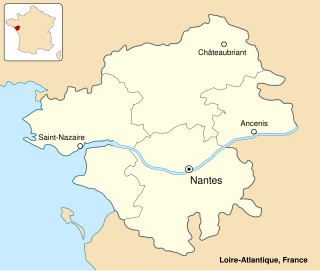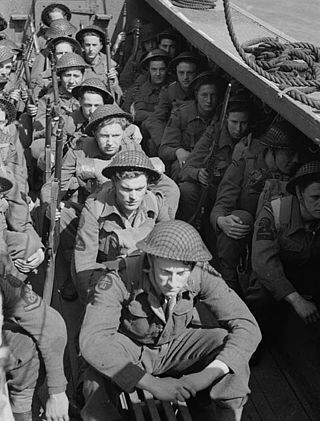Footnotes
- ↑ "List of operational codewords" (PDF). University of Birmingham . Retrieved 4 June 2010.
- ↑ "Operation Aflame". Christopher Chant. Retrieved 19 April 2018.
- ↑ "Raiding as an Intruder Strategy, 1942–1943". Ross. Retrieved 19 April 2018.
For World War II military fire weapons, see M1 flamethrower and M2 flamethrower. For other fire weapons, see Flamethrower (disambiguation).
| Operation Aflame | |||||||
|---|---|---|---|---|---|---|---|
| Part of Operation Overthrow, World War II | |||||||
| |||||||
| Units involved | |||||||
| No. 12 Commando, British Army, UK | |||||||
Operation Aflame was a planned combined operations raid by No. 12 Commando, part of the British army, against Berck in October 1942.
The plan was to have been based on a naval demonstration off the coast, and to have a drop of dummy paratroops and the landing of No. 12 Commando to persuade the Germans that a major landing was about to be made, thereby forcing a major German air response.
Aflame was supposed to be part of the larger strategic operation, Operation Overthrow. [1] [2] [3]

The St Nazaire Raid or Operation Chariot was a British amphibious attack on the heavily defended Normandie dry dock at St Nazaire in German-occupied France during the Second World War. The operation was undertaken by the Royal Navy (RN) and British Commandos under the auspices of Combined Operations Headquarters on 28 March 1942.

The Commandos, also known as the British Commandos, were formed during the Second World War in June 1940, following a request from Winston Churchill, for special forces that could carry out raids against German-occupied Europe. Initially drawn from within the British Army from soldiers who volunteered for the Special Service Brigade, the Commandos' ranks would eventually be filled by members of all branches of the British Armed Forces and a number of foreign volunteers from German-occupied countries. By the end of the war 25,000 men had passed through the Commando course at Achnacarry. This total includes not only the British volunteers, but volunteers from Greece, France, Belgium, Netherlands, Canada, Norway and Poland. The United States Army Rangers and US Marine Corps Raiders, Portuguese Fuzileiros Portuguese Marine Corps were modelled on the Commandos.

Operation Jubilee or the Dieppe Raid was a disastrous Allied amphibious attack on the German-occupied port of Dieppe in northern France, during the Second World War. Over 6,050 infantry, predominantly Canadian, supported by a regiment of tanks, were put ashore from a naval force operating under the protection of Royal Air Force (RAF) fighters.

No. 3 Commando was a battalion-sized Commando unit raised by the British Army during the Second World War. Formed in July 1940 from volunteers for special service, it was the first such unit to carry the title of "Commando". Shortly afterwards the unit was involved in a largely unsuccessful raid upon the German-occupied Channel Island of Guernsey.

No. 4 Commando was a battalion-sized Commando unit of the British Army during the Second World War formed in 1940. Although it was intended to conduct small-scale raids and harass enemy garrisons along the coast of German-occupied France, the unit was mainly employed as a highly trained infantry assault unit.
During World War II, Operation Abercrombie was an Anglo-Canadian reconnaissance raid on the area around the French coastal village of Hardelot, located south of Boulogne-sur-Mer, in the Pas-de-Calais. It had been scheduled for the night of 19/20 April 1942, but delayed until 21/22 April. The raid was largely unopposed but, on review, the benefits were thought not to have been worth the effort. Due to a navigation error the Canadian detachment lost their way and had to abort.

Operation Claymore was a British/Norwegian commando raid on the Lofoten Islands of northern Norway during the Second World War. The Lofoten Islands were an important centre for the production of fish oil and glycerine, used in the German war economy. The landings were carried out on 4 March 1941, by 500 men of No. 3 Commando, No. 4 Commando, and a Royal Engineers section, and 52 men from Norwegian Independent Company 1. Supported by the 6th Destroyer Flotilla and two troop transports of the Royal Navy, the force landed almost unopposed. The original plan was to avoid contact with German forces and inflict the maximum of damage to German-controlled industry. They achieved their objective of destroying fish oil factories and some 3,600 t of oil and glycerine. The force returned with some 228 German prisoners, 314 Norwegian recruits, and a number of Quisling regime collaborators.

The Norwegian heavy water sabotage was a series of Allied-led efforts to halt German heavy water (deuterium) production via hydroelectric plants in Nazi Germany-occupied Norway during World War II, involving both Norwegian commandos and Allied bombing raids. During the war, the Allies sought to inhibit the German development of nuclear weapons with the removal of heavy water and the destruction of heavy-water production plants. The Norwegian heavy water sabotage was aimed at the 60 MW Vemork power station at the Rjukan waterfall in Telemark.

Combined Operations Headquarters was a department of the British War Office set up during Second World War to harass the Germans on the European continent by means of raids carried out by use of combined naval and army forces.

The 1st Special Service Brigade was a commando brigade of the British Army. Formed during the Second World War, it consisted of elements of the British Army and the Royal Marines. The brigade's component units saw action individually in Norway and the Dieppe Raid, before being combined under one commander for service in Normandy during Operation Overlord. On 6 December 1944, the Brigade was redesignated 1st Commando Brigade, removing the title Special Service and its association with the German SS.
No. 5 Commando was a battalion-sized commando unit of the British Army during the Second World War.

No. 6 Commando was a battalion-sized British Army commando unit of the Second World War. Although it was raised to conduct small-scale raids and harass garrisons along the coast of German-occupied France, it was mainly employed as a highly trained infantry assault unit.

No. 10 (Inter-Allied) Commando was a commando unit of the British Army during the Second World War, recruited largely from non-British personnel from German-occupied Europe. This unit was used to help co-ordinate attacks with other Allied forces.
The No. 1 Commando was a unit of the British Commandos and part of the British Army during the Second World War. It was raised in 1940 from the ranks of the existing independent companies. Operationally they carried out a series of small scale cross channel raids and spearheaded the Operation Torch landings in North Africa. They were then sent to the India as part of the 3rd Commando Brigade and took part in operations in the Burma Campaign. During the Second World War, only eight commandos were recipients of the Victoria Cross; two of the eight were from No. 1 Commando. After the war they were sent to reoccupy Hong Kong before being amalgamated with No. 5 Commando to form No. 1/5 Commando. The amalgamated No. 1/5 Commando was disbanded in 1947.
No. 2 Commando was a battalion-sized British Commando unit of the British Army during the Second World War. The first No.2 Commando was formed on 22 June 1940 for a parachuting role at Cambrai Barracks, Perham Down, near Tidworth, Hants. The unit at the time consisted of four troops: 'A', 'B', 'C' and 'D'. Eventually 11 troops were raised. On 21 November, it was re-designated as the 11th Special Air Service (SAS) Battalion and eventually re-designated 1st Parachute Battalion. After their re-designation as the 11th SAS Battalion, a second No. 2 Commando was formed. This No. 2 Commando was the leading commando unit in the St Nazaire Raid and suffered heavy casualties. Those who made it back from St Nazaire rejoined the few who had not gone on the raid, and the commando was reinforced by the first intake of volunteers from the new Commando Basic Training Centre at Achnacarry. No. 2 Commando then went on to serve in the Mediterranean, Sicily, Yugoslavia, and Albania, before being disbanded in 1946.
No. 48 Commando was a battalion-sized formation of the British Commandos, formed in 1944 during the Second World War. No. 48 Commando was assigned to the 4th Special Service Brigade and served in North West Europe, taking part in the Normandy landings and operations around Ostend and Antwerp before being disbanded after the war in January 1946.

The Commandos formed during the Second World War, following an order from the British Prime Minister Winston Churchill in June 1940 for a force that could carry out raids against German-occupied Europe. Churchill stated in a minute to General Ismay on 6 June 1940: "Enterprises must be prepared, with specially-trained troops of the hunter class, who can develop a reign of terror down these coasts, first of all on the "butcher and bolt" policy..." Commandos were all volunteers for special service and originally came from the British Army but volunteers would eventually come from all branches of the United Kingdom's armed forces and foreign volunteers from countries occupied by the Germans. These volunteers formed over 30 individual units and four assault brigades.

Operation Aquatint was the codename for a failed raid by British Commandos on the coast of occupied France during the Second World War. The raid was undertaken in September 1942 on part of what later became Omaha Beach by No. 62 Commando, also known as the Small Scale Raiding Force.
Operation Dryad was a raid on the Casquets lighthouse in the Channel Islands by British Commandos during World War II. The Commandos captured the lighthouse and its occupants and departed leaving no trace that anyone had ever been there.

The Raid onBardia was an amphibious landing at the coastal town of Bardia in North Africa by British Commandos over the night of 19/20 April 1941 during the Second World War. The raid was carried out by No. 7 Commando, also known as A Battalion Layforce, together with a small detachment from the Royal Tank Regiment; the raiders were supported by five navy ships and a submarine. The raid destroyed an Italian artillery battery and a supply dump. It was deemed a success despite the loss of 71 men. The more lasting strategic effect of the raid was the diversion of a German armoured brigade from the front line to provide rear area security.